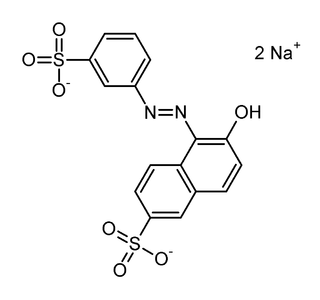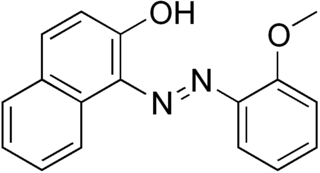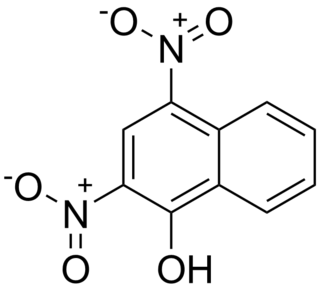
Food coloring, or color additive, is any dye, pigment, or substance that imparts color when it is added to food or drink. They come in many forms consisting of liquids, powders, gels, and pastes. Food coloring is used in both commercial food production and domestic cooking. Food colorants are also used in a variety of non-food applications, including cosmetics, pharmaceuticals, home craft projects, and medical devices.

Anthracene is a solid polycyclic aromatic hydrocarbon (PAH) of formula C14H10, consisting of three fused benzene rings. It is a component of coal tar. Anthracene is used in the production of the red dye alizarin and other dyes. Anthracene is colorless but exhibits a blue (400–500 nm peak) fluorescence under ultraviolet radiation.

Hair coloring, or hair dyeing, is the practice of changing the hair color. The main reasons for this are cosmetic: to cover gray or white hair, to change to a color regarded as more fashionable or desirable, or to restore the original hair color after it has been discolored by hairdressing processes or sun bleaching.

Orange GGN, also known as alpha-naphthol orange, is an azo dye formerly used as a food dye. It is the disodium salt of 1-(m-sulfophenylazo)-2-naphthol-6-sulfonic acid. In Europe, it was denoted by the E Number E111, but has been forbidden for use in foods since 1 January 1978. It has never been included in the food additives list of the Codex Alimentarius. As such, it is forbidden for food use in general, because toxicological data has shown it is harmful.

Safflower, Carthamus tinctorius, is a highly branched, herbaceous, thistle-like annual plant in the family Asteraceae. It is commercially cultivated for vegetable oil extracted from the seeds and was used by the early Spanish colonies along the Rio Grande as a substitute for saffron. Plants are 30 to 150 cm tall with globular flower heads having yellow, orange, or red flowers. Each branch will usually have from one to five flower heads containing 15 to 20 seeds per head. Safflower is native to arid environments having seasonal rain. It grows a deep taproot which enables it to thrive in such environments.

Sudan I, is an organic compound, typically classified as an azo dye. It is an intensely orange-red solid that is added to colourise waxes, oils, petrol, solvents, and polishes. Sudan I has also been adopted for colouring various foodstuffs, especially curry powder and chili powder, although the use of Sudan I in foods is now banned in many countries, because Sudan I, Sudan III, and Sudan IV have been classified as category 3 carcinogens by the International Agency for Research on Cancer. Sudan I is still used in some orange-coloured smoke formulations and as a colouring for cotton refuse used in chemistry experiments.
In organic chemistry, an azo coupling is an organic reaction between a diazonium compound and another aromatic compound that produces an azo compound. In this electrophilic aromatic substitution reaction, the aryldiazonium cation is the electrophile and the activated arene is a nucleophile. In most cases, including the examples below, the diazonium compound is also aromatic.

Allura Red AC is a red azo dye that goes by several names, including FD&C Red 40. It is used as a food dye and has the E number E129.

Light green SF, also called C.I. 42095, light green SF yellowish, is a green triarylmethane dye.
Sudan stains and Sudan dyes are synthetic organic compounds that are used as dyes for various plastics and are also used to stain sudanophilic biological samples, usually lipids. Sudan II, Sudan III, Sudan IV, Oil Red O, and Sudan Black B are important members of this class of compounds.

Sudan Red G is a yellowish red lysochrome azo dye. It has the appearance of an odorless reddish-orange powder with melting point 225 °C. It is soluble in fats and used for coloring of fats, oils, and waxes, including the waxes used in turpentine-based polishes. It is also used in polystyrene, cellulose, and synthetic lacquers. It is insoluble in water. It is stable to temperatures of about 100–110 °C. It was formerly used as a food dye, but still appears to be used for this purpose in china. It is used in some temporary tattoos, where it can cause contact dermatitis. It is also used in hair dyes. It is a component of some newer formulas for red smoke signals and smoke-screens, together with Disperse Red 11.

2-Naphthylamine is one of two isomeric aminonaphthalenes, compounds with the formula C10H7NH2. It is a colorless solid, but samples take on a reddish color in air because of oxidation. It was formerly used to make azo dyes, but it is a known carcinogen and has largely been replaced by less toxic compounds.

Acid orange 20 is an organic compound and an azo dye. It is one of the first water soluble dyes to be commercialized, and one of seven original food dyes allowed under the U.S. Pure Food and Drug Act of June 30, 1906. It is analyzed by HPLC.

2-Naphthol, or β-naphthol, is a fluorescent colorless (or occasionally yellow) crystalline solid with the formula C10H7OH. It is an isomer of 1-naphthol, differing by the location of the hydroxyl group on the naphthalene ring. The naphthols are naphthalene homologues of phenol, but more reactive. Both isomers are soluble in simple alcohols, ethers, and chloroform. 2-Naphthol is a widely used intermediate for the production of dyes and other compounds.

Martius yellow is an organic compound that once was used to protect wool from moths. It is prepared by nitration of naphthol.

Acid Orange 7, also known as 2-naphthol orange is an azo dye. It is used for dyeing wool. It is produced by azo coupling of β-naphthol and diazonium derivative of sulfanilic acid.
1-Naphthol, or α-naphthol, is a fluorescent organic compound with the formula C10H7OH. It is a white solid. It is an isomer of 2-naphthol differing by the location of the hydroxyl group on the naphthalene ring. The naphthols are naphthalene homologues of phenol, with the hydroxyl group being more reactive than in the phenols. Both isomers are soluble in simple alcohols, ethers, and chloroform. They are precursors to a variety of useful compounds. Naphthols are used as biomarkers for livestock and humans exposed to polycyclic aromatic hydrocarbons.

Acid red 88 is an azo dye. Due to its intense colour, solid samples appear almost black. It is used to dye cotton textiles red. A closely related acid dye is Acid Red 13.

Ponceau 3R is an azo dye that once was used as a red food colorant. It is one of a family of Ponceau dyes.

4-Amino-2-methyl-1-naphthol is a menadione analog. Its hydrochloride (HCl) salt is often called vitamin K5. The HCl salt has been used as a medicine for vitamin K deficiency under tradenames such as Synkamin, which was sold by Parke-Davis, but has since been discontinued.



















